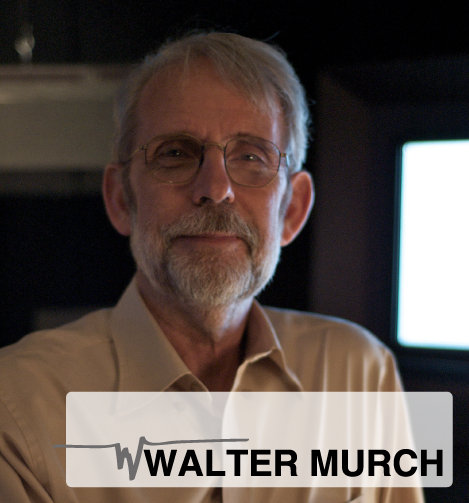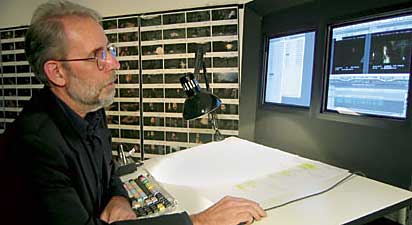For Octuber, I’ll make an special of Walter Murch, a master known for his fantastic work as sound editor/sound designer for several years ago. He make a lot of innovations and has received several awards for sound of amazing films such as The Conversation, Apocalypse Now, The English Patient and many others.
Bio
Walter Scott Murch is an film editor/sound designer, the son of painter Walter Tandy Murch (1907-1967). He went to The Collegiate School, a private preparatory school in Manhattan, from 1949 to 1961. He then attended Johns Hopkins University from 1961 to 1965, graduating in Liberal Arts. While at Hopkins, he met future director/screenwriter Matthew Robbins and cinematographer Caleb Deschanel, with whom he staged a number of happenings. In 1965, Murch and Robbins enrolled in the graduate program of the University of Southern California film school, successfully encouraging Deschanel to follow them. There all three encountered, and became friends with fellow students such as George Lucas, Hal Barwood, Robert Dalva, Willard Huyck, Don Glut and John Milius, forming a clique of friends collectively known as The Dirty Dozen. All of them would go on to be successful filmmakers.
Murch started editing and mixing sound with Francis Ford Coppola’s The Rain People (1969). Subsequently, he worked on George Lucas’s THX 1138, American Graffiti and Coppola’s The Godfather before editing picture and mixing sound on Coppola’s The Conversation, for which he received an Academy Award nomination in sound in 1974. Murch also mixed the sound for Coppola’s The Godfather Part II which was released in 1974, the same year as The Conversation. He is most famous for his sound designing work on Apocalypse Now, for which he won his first Academy Award in 1979. In 1985 he directed his one film, Return to Oz, which he co-wrote with Gill Dennis.
Unlike most film editors today, Murch works standing up, comparing the process of film editing to “conducting, brain surgery and short-order cooking”, since all conductors, cooks and surgeons stand when they work. In contrast, when writing, he does so lying down. His reason for this is that where editing film is an editorial process, the creation process of writing is opposite that, and so he lies down rather than sit or stand up, to separate his editing mind from his creating mind.
Murch has written one book on film editing, In the Blink of an Eye (2001).Murch was the subject of Michael Ondaatje’s book The Conversations (2002); the book, which incorporates from several conversations between Ondaatje and Murch, emerged from Murch’s editing of The English Patient, which was based on Ondaatje’s novel of the same name.
While he was editing with film, Murch took notice of the crude splicing used for the daily rough-cuts. In response, he invented a film splicer which concealed the splice by using extremely narrow but strongly adhesive strips of special polyester-silicone tape. He called his invention “In-vis-o”.
In 1979, he won an Oscar for the sound mix of Apocalypse Now as well as a nomination for picture editing. Murch is widely acknowledged as the person who coined the term Sound Designer, and along with colleagues developed the current standard film sound format, the 5.1 channel array, helping to elevate the art and impact of film sound to a new level. Apocalypse Now was the first multi-channel film to be mixed using a computerized mixing board. In 1996, Murch worked on Anthony Minghella’s The English Patient, which was based on Michael Ondaatje’s novel of the same name. Murch won Oscars both for his sound mixing and for his editing. Murch’s editing Oscar was the first to be awarded for an electronically edited film (using the Avid system), and he is the only person ever to win Oscars for both sound mixing and film editing.
In 2003, Murch edited another Anthony Minghella film, Cold Mountain on Apple’s sub-$1000 Final Cut Pro software using off the shelf Power Mac G4 computers. This was a leap for such a big-budget film, where expensive Avid systems were usually the standard non-linear editing system. He received an Academy Award nomination for this work; his efforts on the film were documented in Charles Koppelman’s 2004 book Behind the Seen. In 2006, he was awarded an honorary Doctorate of Letters by the Emily Carr Institute of Art and Design in Vancouver, Canada.
Some Awards & Nominations
- Academy Award Nomination for Best Editing – Cold Mountain
- Academy Award for Best Film Editing and Best Sound – The English Patient
- Academy Award Nomination for Best Film Editing – Ghost
- Academy Award for Best Film Editing – The Godfather: Part III
- Academy Award for Best Sound and Nomination for Best Film Editing – Apocalypse Now
- Academy Award Nomination for Best Film Editing – Julia
- Academy Award Nomination for Best Sound – The Conversation
- BAFTA Film Award for Best Editing and Nomination for Best Sound – The English Patient
- BAFTA Film Award for Best Sound Track and Best Film Editing – Apocalypse Now
Featured Work
- Tetro (2009) – Sound re-recording mixer
- Seeing in the Dark (2007) – Sound mixer
- Jarhead (2005) – Sound re-recording mixer
- Dickson Experimental Sound Film (1894) – Sound designer
- Cold Mountain (2003) – Sound re-recording mixer
- Touch of Evil (1958) – Sound re-recordist
- The English Patient (1996) – Sound re-recording mixer
- First Knight (1995) – Sound re-recording mixer
- Crumb (1994) – Sound re-recording mixer
- The Godfather: Part III (1990) – Sound re-recording mixer
- Ghost (1990) – Sound re-recording mixer
- Dragonslayer (1981) – Sound re-recording mixer
- Apocalypse Now (1979) – Sound designer and Sound montage and Sound re-recording mixer
- The Godfather: Part II (1974) – Sound montage and Sound re-recordist
- The Conversation (1974) – Sound editor and Sound montage – Sound re-recordist
- American Graffiti (1973) – Sound montage and Sound re-recordist
- THX 1138 (1971) – Sound montage
- Gimme Shelter (1970) – Sound
- The Great Walled City of Xan (1970) – Sound
- The Rain People (1969) – Sound montage

